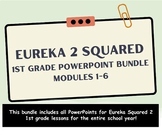Eureka Squared 2 1st Grade Module 1 Bundle
Magnolia Square
98 Followers
Grade Levels
1st
Subjects
Resource Type
Standards
CCSS1.MD.C.4
CCSS1.NBT.C.4
CCSS1.OA.A.1
CCSS1.OA.B.3
CCSS1.OA.C.6
Formats Included
- Zip
Magnolia Square
98 Followers
What educators are saying
We love using these over the slide Eureka provides. These are much more engaging and laid out really easy to follow.
This is a perfect resource that perfectly aligns with EM2 math. I will definitely be purchasing all the modules.
Products in this Bundle (25)
showing 1-5 of 25 products
Also included in
- Eureka Squared 2 1st Grade Powerpoint Bundle Modules 1-6. This bundle includes all powerpoints for Eureka Squared 2 1st grade lessons for the entire school year!Price $143.00Original Price $178.75Save $35.75
Description
Eureka Squared 2 1st Grade Module 1 Lessons 1-25 Powerpoints
Total Pages
Answer Key
N/A
Teaching Duration
N/A
Report this resource to TPT
Reported resources will be reviewed by our team. Report this resource to let us know if this resource violates TPT’s content guidelines.
Standards
to see state-specific standards (only available in the US).
CCSS1.MD.C.4
Organize, represent, and interpret data with up to three categories; ask and answer questions about the total number of data points, how many in each category, and how many more or less are in one category than in another.
CCSS1.NBT.C.4
Add within 100, including adding a two-digit number and a one-digit number, and adding a two-digit number and a multiple of 10, using concrete models or drawings and strategies based on place value, properties of operations, and/or the relationship between addition and subtraction; relate the strategy to a written method and explain the reasoning used. Understand that in adding two-digit numbers, one adds tens and tens, ones and ones; and sometimes it is necessary to compose a ten.
CCSS1.OA.A.1
Use addition and subtraction within 20 to solve word problems involving situations of adding to, taking from, putting together, taking apart, and comparing, with unknowns in all positions, e.g., by using objects, drawings, and equations with a symbol for the unknown number to represent the problem.
CCSS1.OA.B.3
Apply properties of operations as strategies to add and subtract. If 8 + 3 = 11 is known, then 3 + 8 = 11 is also known. (Commutative property of addition.) To add 2 + 6 + 4, the second two numbers can be added to make a ten, so 2 + 6 + 4 = 2 + 10 = 12. (Associative property of addition.)
CCSS1.OA.C.6
Add and subtract within 20, demonstrating fluency for addition and subtraction within 10. Use strategies such as counting on; making ten (e.g., 8 + 6 = 8 + 2 + 4 = 10 + 4 = 14); decomposing a number leading to a ten (e.g., 13 - 4 = 13 - 3 - 1 = 10 - 1 = 9); using the relationship between addition and subtraction (e.g., knowing that 8 + 4 = 12, one knows 12 - 8 = 4); and creating equivalent but easier or known sums (e.g., adding 6 + 7 by creating the known equivalent 6 + 6 + 1 = 12 + 1 = 13).



